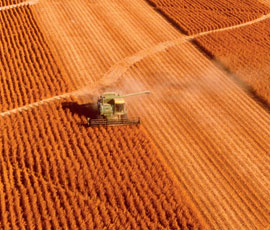Commodity markets turmoil gives good buying opportunities

Global economic troubles have created good opportunities to buy, reports KW’s Colin Shepherd.
The European debt crisis and weak US economy once again hit the headlines at the start of August, causing a worldwide sell-off by many of the major investors.
This not only sent share prices crashing, but also had significant knock-on effects for the feed commodity markets.
As a result, it was the movement of investment funds out of the main feed commodities that had the biggest impact on worldwide feed prices. For the UK livestock farmer, this created some good buying opportunities, with both soya bean meal and rapemeal prices dropping back by about £10/t.
For these prices not to have come back further, given the scale of the international turmoil, it would suggest that most still see demand for proteins equalling, or slightly exceeding, available supply. But the picture isn’t as clear cut as it once was.
Poor weather in the US in July – it was the fifth hottest on record – came early in the soya bean growing season, but still caused USDA (United States Department of Agriculture) estimates for soya bean yields to be cut by 4.6%. And although the rain in Europe during June improved prospects for the European oilseed rape crop, production is still predicted to be 1.5m tonnes lower than last year.
Against this, however, is a slight reduction in protein demand from China, with rumours once again surfacing of a possible Chinese interest rate rise in the near future, a move that would reduce the country’s appetite for imports. China also continues to favour South American soya beans over those from the US, due to both a better price and good supply following an exceptional harvest.
Every month longer that Brazil and Argentina supply China, US export estimates fall, and predicted carry-out stocks increase. As a result, there’s a slowly emerging view that maybe global stocks and supplies can now meet demand, a situation that could allow protein prices to ease back in due course.
But with no real clarity at this point in time, and soya bean yield estimates now being revised downwards, the advice is to take advantage of recent market falls to cover at least 50% of winter protein requirements. The drop in rapemeal values also means that heat-treated rapemeal is once again a very cost-effective alternative to soya bean meal, and should be considered alongside other rumen-bypass proteins, such as rumen-protected soya bean meal, as part of a strategy to save £30-50/t by reducing the need for hi-pro soya bean meal.
In terms of energy feeds, the hot July weather in the US came during a key pollination period for corn, reducing USDA yield estimates by 3.5% and sending corn prices into uncharted territory. Yet despite this, the London wheat futures market remained relatively stable through early August, trading between £155-165/t.
The exchange rate is making UK exports uncompetitive, with Russia quick to take advantage of the situation to secure many of the contracts currently available. And with only 5m tonnes of a predicted 18m tonnes export surplus accounted for, Russia looks set to continue dominating the wheat export market for some time.
Combined with rumours of quality issues in parts of Europe that are likely to see some milling wheat downgraded, the scene is set for Europe to be left with higher-than-expected volumes of feed wheat. It would appear that there’s room for most energy feed prices to fall further before the end of the summer.
Of the exceptions to this, soya hulls remain well priced for the winter at about £148/t, although with sugar beet feed prices released at the end of August, there may soon be another option for those needing digestible fibre. Liquid feeds are also still among the best buys for energy, continuing to compare very favourably against cereals and with winter contracts now available on most.
Rumen-protected fats are also worth considering. Prices for the major ingredient used to manufacture protected fats – palm fatty acid distillate or PFAD – have risen as a result of one major German compounder having already covered its entire winter’s requirement.
A similar move was partly responsible for the start of a rally in prices last summer that continued throughout the winter. Take cover through to December to guard against a repeat this year, and keep up to date on prices for the rest of the winter.
feedwatch

